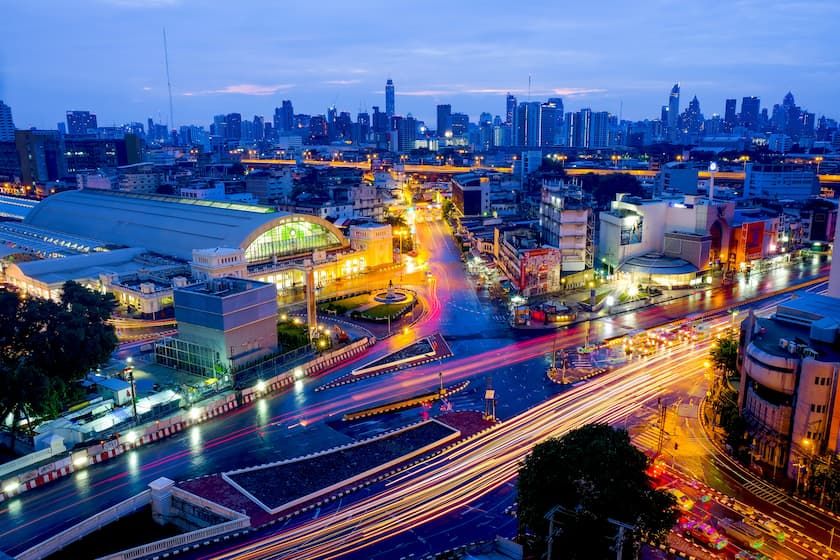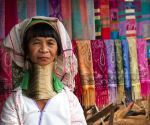Museums of Arts, Culture and Architecture in Bangkok
Bangkok is a melting pot of cultures with a rich and dynamic history. We explore the museums in this exciting city that provide visitors and locals with a glimpse into Thai art, culture and architecture, and how they have developed over the centuries.

Art, Culture & Architecture in Bangkok
Jim Thompson House Museum & Art Centre
Jim Thompson came to Bangkok from America as a military officer after WWII. He developed a fascination with the dying art of weaving traditional Thai silk and, in an effort to revive this industry, he started the Thai Silk Company in 1948 once his military service was over. He achieved massive success and became known as the Thai Silk King.
The Jim Thompson House Museum is his former home, where he lived from 1959 until 1967, when he mysteriously disappeared in Malaysia. It’s built in a traditional Thai style, and houses his private collection of carvings, statues, chandeliers and Thai images, with the interior much the same as before his disappearance. It gives a true picture of the life of this well-known figure.
The art centre is in the grounds of the museum complex in Rama I Road, here you can see traditional and modern art from both Thai and international artists.
The Erawan Museum
Erawan is one of the Thai names for the mythological three-headed elephant Airavata, a solid bronze statue of which is the centrepiece of the Erawan Museum. The museum showcases the history of the Thai cultures, religions and faith-based customs from past to present. It’s located in the Samut Prakan Province, about 20 minutes from the hotel.
The museum spreads over three floors in the statue itself and is designed to represent the Hinduidea of the universe. The first floor is in the statue’s pedestal and represents the underworld, with a collection of Chinese vases from the Ming and Qing Dynasties. Also in the pedestal is earth on the second floor, with more precious antiques and artefacts. Heaven is the top floor and in the elephant’s belly. Here, you’ll find relics of Buddha and ancient Buddha statues.
The National Gallery
The former Royal Thai Mint in the Phra Nakhon District houses the National Gallery, an art gallery with exhibitions covering everything from traditional Thai art to modern and contemporary pieces. The gallery is about a 25-minute drive from the Akyra Thonglor on the Chao Fa Road.
The exhibitions are spread over two floors, and include a collection of works painted by former Kings of Thailand. The upper level focuses on Thai cultural art, with pieces that tell the story of Thai legends and traditions.
Ratchadamnoen Contemporary Art Centre
The Ratchadamnoen Contemporary Art Centre provides a space for Thai artists to create and display their contemporary art works. In the 1930s, the site held a group of shophouses built in a European style, before the buildings were renovated into the art centre in commemoration of the 84th Royal birthday of King Bhumibol.
The three stories house several exhibitions, and include an auditorium, workshop, an Asian Cultural Centre and The Centre of Thai Inspiration. The area outside the art centre bustles with food vendors, practising artists and visitors enjoying the vibe and a bite to eat.
Museum of Contemporary Art (MOCA)
Bangkok’s Museum of Contemporary Art (MOCA) in Chatuchak is the creation of art lover Boonchia Bencharongkul. It displays no less than 800 exceptional pieces from his personal art collection, lovingly curated over more than 30 years.
The museum comprises five stories with displays that portray how fine art has developed in Thailand over the years. You can view several permanent exhibitions by established Thai artists, but also explore modern works that don’t just depict traditional themes like religion and culture, but also darker themes like prostitution.
Rattanakosin Exhibition Hall
The Rattanakosin Exhibition Hall details Thai history, arts and culture through the Rattanakosin Era. Displays are spread over nine halls, each showcasing a different topic through the use of both physical displays and multimedia presentations.
Guided tours run every 20 minutes and cover Thai history since 1782, including the history of the city, Grand Palace and Emerald Buddha. Interactive displays bring Thai history to life, telling its story in an innovative and entertaining way.
Suan Pakkad Palace
This fine example of Thai architecture was once the home of Prince & Princess Chumbhot. The museum comprises eight traditional Thai houses surrounded by tranquil gardens dotted about with calming ponds.
The centrepiece of the complex is four traditional northern Thai style teak houses interconnected by bridges. These houses contain a collection of musical instruments, relics and Buddha images from various periods in Thai history, and a selection of decorative household items and Thai furniture. Another group of four houses showcases prehistoric arts and artefacts, and an exhibition depicting the traditional Thai masked dance.
But the main attraction of the museum is the Lacquer Pavilion dating back to the 17th century, which the prince gifted his princess in 1959. This stunning structure is a fine piece of Thai architecture, decorated with wooden carvings and a black lacquer interior with gold murals.
Nai Lert Park Heritage Home
The Nai Lert Park Heritage Home was the one-time residence of its designer Phraya Bhakdinorasreth, who was also known as Nai Lert. He built this unique teakwood home on a large piece of land alongside the Saen Saep Canal, with the intentions of having a relaxing residence surrounded by lush gardens.
The gardens opened to the public in 1915 and became the first public park in Bangkok that was modelled on those in the western world. The house was converted to a museum in 2012, with memorabilia and artefacts covering the life of Nai Lert and his family.
Golden Teak Museum
The majestic Golden Teak Museum was originally built in the Phrae province, an area renowned for its teak. It was later deconstructed and rebuilt in the Dusit district of Bangkok, in the grounds of the Wat Therawat Kunchorn on the banks of the Chao Phraya River.
The centrepiece of the museum is the 59 golden teak pillars that are the supporting structure of the building, and are over 500 years old. Entering the museum, you’ll encounter a wooden block and exhibition that tells the story of the history and growth of the teak and how they correspond to the growth rings. The second floor houses several Buddha images and the Lord Buddha’s relics, along with a display of fibreglass statues of notable Thai monks from the Ayutthaya to the Rattanakosin periods.
Charoen Chai Community Museum
Nestled in the heart of Bangkok’s vibrant Chinatown is the Charoen Chai Community Museum, the former home of a group of Chinese opera artists who settled there in the late 1700s. The area became known for its Chinese joss paper, which is used in many Chinese religious rituals.
The Charoen Chai Community bustles with local shops that have been passed down through the generations and maintain many of the old traditions. The museum preserves the history and culture of the Charoen Chai community, and affords visitors a glimpse into the authenticity of the area.
Silpa Bhirasri Memorial National Museum
This modern art museum is located in the grounds of the Ministry of Culture’s Fine Arts Department adjacent to The Royal Grand Palace. It opened in 1984 to honour Professor Silpa Bhirasri who was a leader in the growth of modern and contemporary art in the country. Among other things, he started the National Exhibition of Art in 1949 to encourage the development of contemporary art, and promoted art exchanges between international and Thai artists.
The museum is in two parts. In the first, you can view paintings, sculptures and other art works produced by his students, while the second displays the equipment and tools the professor used to create his pieces of art.
Sermkhun Kunawong Museum House
This privately owned museum opened in 1992 and is the brainchild of Sermkuhn Kunawong who is a passionate advocate for Thai art. The Museum House displays hundreds of artefacts and artworks that show how Thai art has developed over the years.
The Sermkuhn Kunawong Museum House is split into 12 sections, each with a different theme and focus. Among these are the Garden of Buddhist Sculptures, the Thai Heritage Room, the Portrait Hall with more than 40 pieces, the Meditation Room and the Thai Way of Life Garden. Each zone tells its story through an impressive exhibition of work that the museum preserves for posterity and the benefit of future generations.
Bangkok Museums Map
Related Articles
- Museums in Bangkok
- Interesting and Unusual Museums in Bangkok
- Science & Nature Museums in Bangkok
- Exploring Bangkok's Temples
- Exploring Bangkok's Old Buildings




